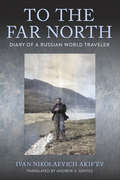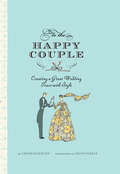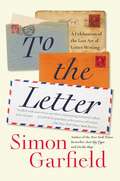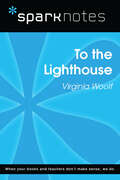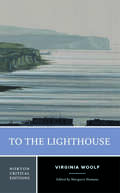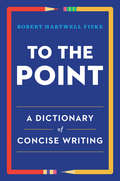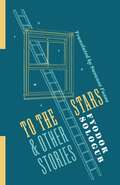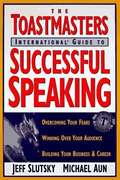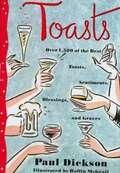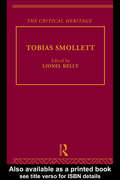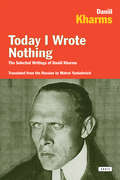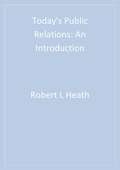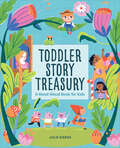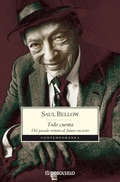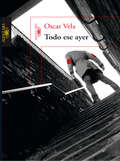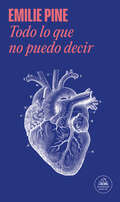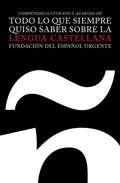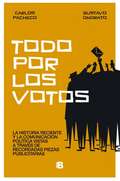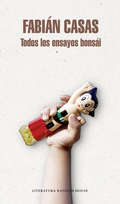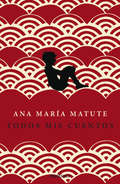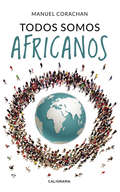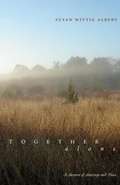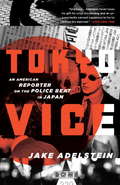- Table View
- List View
To the Far North: Diary of a Russian World Traveler (NIU Series in Slavic, East European, and Eurasian Studies)
by Ivan Nikolaevich Akif’ëvThis annotated translation of To the Far North presents the diary of a twenty-seven-year-old Russian physician who was part of the 1900 expedition to the Chukotka Peninsula to find gold. No other account so richly details life along the North Pacific Rim before World War I, especially from a Russian perspective. This volume relates the expedition's formation, development, and aftermath and offers unique insights on the region's place in both Russian policymaking and geopolitics. The illustrated diary includes picturesque descriptions of San Francisco, the Nome Gold Rush, Chukchi culture, Petropavlovsk, Vladivostok, and Nagasaki, Japan.Andrew A. Gentes's translation is based on an edition of Akifëv's book that was published in St. Petersburg in 1904. The diary shows how Russian and American views and cultural values clashed over a territory that is today more geopolitically important than ever. By documenting Akifëv's personal travels outside the expedition, To the Far North also demonstrates, in both human and personal terms, the role Russians played in shaping this region's history.
To the Happy Couple: Creating a Great Wedding Toast with Style
by Sarah McElwainNow here's something worth raising a glass to: the perfect how-to guide and resource for preparing, writing, and presenting the best wedding toast ever (butterflies not included). With clear explanations of who traditionally offers a toast and when, To the Happy Couple also gives useful information on fitting toasts for rehearsal dinners, bridal showers, and bachelor parties. Tips include avoiding the pitfalls of public speaking and advice on which topics work well and which should be avoided (don't bring up that first marriage...). There are plenty of suggestions for finding quotes, whether from song lyrics, poems, or other sources, examples of how to use them to enhance and personalize the message, plus a variety of quotes in the back of the book to provide additional inspiration. Beautifully illustrated throughout with whimsical drawings, To the Happy Couple is both a practical guide and a lovely gift for anyone who has ever had to say, "I'd like to make a toast..."
To the Letter
by Simon GarfieldTo the Letter tells the story of our remarkable journey through the mail. From Roman wood chips discovered near Hadrian's Wall to the wonders and terrors of email, Simon Garfield explores how we have written to each other over the centuries and what our letters reveal about our lives. Along the way he delves into the great correspondences of our time, from Cicero and Petrarch to Jane Austen and Ted Hughes (and John Keats, Virginia Woolf, Jack Kerouac, Anaïs Nin and Charles Schulz), and traces the very particular advice offered by bestselling letter-writing manuals. He uncovers a host of engaging stories, including the tricky history of the opening greeting, the ideal ingredients for invisible ink, and the sad saga of the dead letter office. As the book unfolds, so does the story of a moving wartime correspondence that shows how letters can change the course of life. To the Letter is a wonderful celebration of letters in every form, and a passionate rallying cry to keep writing.
To the Letter
by Simon GarfieldThe New York Times bestselling author of Just My Type and On the Map offers an ode to letter writing and its possible salvation in the digital age. Few things are as exciting--and potentially life-changing--as discovering an old letter. And while etiquette books still extol the practice, letter writing seems to be disappearing amid a flurry of e-mails, texting, and tweeting. The recent decline in letter writing marks a cultural shift so vast that in the future historians may divide time not between BC and AD but between the eras when people wrote letters and when they did not. So New York Times bestselling author Simon Garfield asks: Can anything be done to revive a practice that has dictated and tracked the progress of civilization for more than five hundred years? In To the Letter, Garfield traces the fascinating history of letter writing from the love letter and the business letter to the chain letter and the letter of recommendation. He provides a tender critique of early letter-writing manuals and analyzes celebrated correspondence from Erasmus to Princess Diana. He also considers the role that letters have played as a literary device from Shakespeare to the epistolary novel, all the rage in the eighteenth century and alive and well today with bestsellers like The Guernsey Literary and Potato Peel Pie Society. At a time when the decline of letter writing appears to be irreversible, Garfield is the perfect candidate to inspire bibliophiles to put pen to paper and create "a form of expression, emotion, and tactile delight we may clasp to our heart."
To the Lighthouse (SparkNotes Literature Guide Series)
by SparkNotesTo the Lighthouse (SparkNotes Literature Guide) by Virginia Woolf Making the reading experience fun! Created by Harvard students for students everywhere, SparkNotes is a new breed of study guide: smarter, better, faster. Geared to what today's students need to know, SparkNotes provides: *Chapter-by-chapter analysis *Explanations of key themes, motifs, and symbols *A review quiz and essay topicsLively and accessible, these guides are perfect for late-night studying and writing papers
To the Lighthouse: A Norton Critical Edition (Norton Critical Editions #0)
by Virginia Woolf“One of Woolf's most beloved novels, To the Lighthouse, finally gets a Norton Critical Edition. In Margaret Homans, To the Lighthouse has an ideal editor, for Homans brings her deep knowledge of the Victorian world Woolf portrays, her long admiration for Woolf, and her feminism to bear on the novel. The generous and welcoming introduction will help new and returning readers to explore the rich contextual and critical material that accompanies the text. The abundant and diverse materials here—from writings by Woolf’s parents and fairy tales, to physics and art, to early reviews and recent criticism—will all support a wide range of critical approaches and invite new readings. What a treat for readers!” —Anne Fernald, Fordham University “Margaret Homans’ vision of To the Lighthouse is replete. A magnificent array of contexts complements the annotated text, including familial and literary sources for the novel; a chronology of its composition and reception; early reviews; and scholarly interpretations addressing gender, empire, and the role of the artist. The introduction considers the novel’s debt to philosophy, its structure and style, its revelation of the social changes wrought by World War I, and the effect of its Scottish setting. Having studied Woolf with Margaret Homans as an undergraduate, I am delighted that her thoughtful teaching is now widely available in this wonderful classroom edition.” —Emily Kopley, McGill University “What excellent choices! This splendid edition of To the Lighthouse will make all the difference, thanks to its dynamic array of explanatory contexts, backgrounds, and sources—its ideal set of historical, political, theoretical, and biographical frameworks. The editor’s introduction is a marvelous crash course in the many points of interest that have made To the Lighthouse so essential, and the edition as a whole, with its authoritative text and diverse pathways for interpretation, is really perfect for everyone from general readers to students in courses at all levels to the most seasoned Woolfians. This Norton edition has it all. It’s the single best option for anyone who wants to know everything about To the Lighthouse.” —Jesse Matz, Kenyon College This Norton Critical Edition includes: The American edition of the novel, first published by Harcourt Brace in 1927, introduced and annotated by Margaret Homans. A 1924-28 chronology of To the Lighthouse’s composition, revision, publication, and reception. A rich selection of background materials, thematically organized for ease of reference. Topics include: “Autobiographical Writings,” “Family and Other Contemporary Contexts and Sources,” “Essays by Virginia Woolf,” and “Literary Sources.” Nine critical assessments of To the Lighthouse, from publication to the present day, by Arthur Sydney McDowell, Louis Kronenberger, Mary Colum, Francis Brown, Erich Auerbach, Adrienne Rich, Rachel Bowlby, Pamela L. Caughie, and Urmila Seshagiri. A chronology and a selected bibliography This purchase offers access to the digital ebook only.
To the Point: A Dictionary of Concise Writing
by Robert Hartwell FiskeThe essential guide to writing succinctly. Who doesn't hate wading through wordy paragraphs? Unfortunately, many writers don't realize when they are padding their sentences and obscuring their meaning. Enter To the Point, the essential guide to writing succinctly. Featuring hundreds of new entries, this freshly updated edition is complete with: * A guide to the basics of writing concisely, including how to reduce the number of words in a phrase, substitute a single word for a phrase, and delete extraneous words and phrases. * The "Dictionary of Concise Writing," which gives concise alternatives to thousands of wordy phrases. Language expert Robert Hartwell Fiske uses each wordy phrase in a sentence and then rewrites or deletes the phrase entirely to show how the sentence can be improved. * The brand new "Guide to Obfuscation: A Reverse Dictionary," which helps writers build a more pithy vocabulary. To the Point is the perfect reference book for anyone who wants to communicate more effectively through clear and beautiful writing.
To the Stars and Other Stories (Russian Library)
by Fyodor SologubA boy who feels persecuted by the banality of everyday life yearns to ascend to the cold and majestic plane of the stars. A seamstress finds liberation of a sort in “becoming” a dog and howling at the moon. A club of young girls masquerade as the grieving fiancées of strange men. This book brings together these and other remarkable short stories by the Russian Symbolist Fyodor Sologub that explore the lengths to which people will go to transcend the mundane.Renowned as one of late imperial Russia’s finest stylists, Sologub bridges the great nineteenth-century novel and the fin-de-siècle avant-garde. He stands out for his masterful command of both realist and fantastic storytelling; his play with language evinces a belief in its capacity to access other worlds and other levels of meaning. Many of Sologub’s stories are set among children whose alienation from the adult world has lent them imagination and curiosity, enabling them to create an alternative reality. At the same time, he bluntly examines the sordid realities of late imperial Russian society and frankly presents sometimes unconventional sexuality. The book also features a selection of Sologub’s “little fairy tales,” ambiguous parables couched in childlike language whose ingenuity anticipates the miniatures and “incidents” of Daniil Kharms. Susanne Fusso’s elegant translation offers these artful tales to an English-speaking audience.
Toastmasters International Communication and Leadership Program
by Toastmasters InternationalIncluded here is the manual that you get upon first joining a Toastmasters club. Toastmasters is an organization which teaches its members how to speak effectively. Even if the reader is not a member of a Toastmasters club, it will be of some use to those who want to learn some good ways to prepare different types of speeches. Otherwise, this just might spur you to find and joina Toastmasters club and have fun. This has been specially edited to make navigation with braille or daisy through the manual an easy and enjoyable task.
Toasts: Over 1,500 of the Best Toasts, Sentiments, Blessings, and Graces
by Paul DicksonA list of speeches for any occasion.
Tobias Smollett: The Critical Heritage
by Lionel KellyThe Critical Heritage gathers together a large body of critical sources on major figures in literature. Each volume presents contemporary responses to a writer's work, enabling student and researcher to read the work themselves.
Today I Wrote Nothing: The Selected Writings of Daniil Kharms
by Daniel KharmsA master of formally inventive poetry and what today would be called micro-fiction, Kharms built off the legacy of Russian Futurist writers to create a uniquely deadpan style written out of and in spite of the absurdities of life in Stalinist Russia. Featuring the acclaimed novella The Old Woman and darkly humorous short prose sequence Events (Sluchai), Today I Wrote Nothing also includes dozens of short prose pieces, plays, and poems long admired in Russia, but never before available in English. A major contribution for American readers and students of Russian literature and an exciting discovery for fans of contemporary writers as eclectic as George Saunders, John Ashbery, and Martin McDonagh, Today I Wrote Nothing is an invaluable collection for readers of innovative writing everywhere. Daniil Kharms has long been heralded as one of the most iconoclastic writers of the Soviet era, but the full breadth of his achievement is only in recent years, following the opening of Kharms' archives, being recognized internationally. In this brilliant translation by Matvei Yankelevich, English-language readers now have a comprehensive collection of the prose and poetry that secured Kharms s literary reputation a reputation that grew in Russia even as the Soviet establishment worked to suppress it.
Today's Public Relations: An Introduction
by Robert L. Heath Timothy CoombsToday's Public Relations: An Introduction is a comprehensive text that features all aspects of public relations with specific sensitivity to the message strategies that challenge practitioners to be successful, yet ethical. In this book, authors Robert L. Heath and W. Timothy Coombs redefine the teaching of public relations by discussing its connection to mass communication while linking it to its rhetorical heritage. The text features coverage of ethics, research, strategy, planning, evaluation, media selection, promotion and publicity, crisis communication, risk communication, and collaborative decision making as ways to create, maintain, and repair relationships between organizations and the persons who can affect their success.
Toddler Story Treasury: A Read Aloud Book for Kids
by Julie KierasRead cherished classic stories aloud—for toddlers ages 1 to 3 Toddlers love listening to a story, especially when it's read by someone they love. But how can you fit this beloved tradition into a busy day or night? This toddler reading book offers much-loved tales that are shortened, so it's easy to make time for them—even if your toddler asks for "just one more." Cozy up with 30 stories—Delight your toddler with classic tales to enjoy over and over again, including "The Three Little Pigs," "The Little Duckling," "Beauty and the Beast," "Tom Thumb," and many more. Enchanting pictures tell the story—Discover whimsical illustrations that enhance the playfully retold condensed tales. Teach skills with stories—Experience how reading aloud helps kids build vocabulary, grow emotionally, and learn effective listening. Give a gift more fitting than a glass slipper: reading aloud from this storybook for toddlers.
Todo cuenta: Del pasado remoto al futuro incierto
by Saul BellowUna recopilación de ensayos, artículos, ponencias y apuntes de viaje de Saul Bellow que abarca, prácticamente, toda la vida del autor. Más de treinta textos publicados en revistas y periódicos en los que la astuta mirada de Bellow recoge desde un magnífico retrato de la ciudad de Chicago, la firma del tratado de paz entre Egipto e Israel, o impresiones sobre sus colegas, hasta una descripción de la sociedad española de posguerra. Pero es, sobre todo, su lamento por la pérdida de responsabilidad del novelista en la tarea de construir una literatura que sea vehículo de «impresiones verdaderas» lo que compone el corazón de este libro. Una crítica devastadora a sus contemporáneos que ejemplifica a la perfección el texto leído en la recepción del Nobel. Y como colofón, tres entrevistas en las que reflexiona sobre la lectura, la escritura, la enseñanza y la vida. Reseña: «Frase a frase, página a página, Bellow es, simplemente, el mejor escritor que tenemos.»The New York Times Book Review
Todo ese ayer
by Óscar VelaSebastián, un joven argentino que en la rebeldía dela adolescencia decidió colaborar con los Montoneros,fue capturado, torturado y desaparecido durantela dictadura del general Jorge Videla. Treinta y cuatroaños más tarde, Federico, su amigo de la juventud,recibe un extraño mensaje que altera los hechossupuestos del pasado y cambia definitivamente elrumbo de su vida. Esos días, en medio de una confusaprotesta policial que provoca graves incidentespolíticos, Rocío se encuentra repetidamente conquien ella cree es Cristo, venido para colmarla defe tras el devastador descubrimiento de los secretosmás íntimos de su marido.Las historias de estos personajes están conectadaspor viles manipulaciones que pretenden encubrir laverdad. Pero antes de que se puedan atar todos loscabos, habrá que preguntarse: ¿quién nos está contandoesta historia, y por qué?Oscar Vela conecta ciertos eventos de la realidad latinoamericanacon una destreza
Todo lo que no puedo decir
by Emilie PineEn Todo lo que no puedo decir, Emilie Pine nos trae seis relatos autobiográficos que quieren romper el más antiguo de los pactos de silencio: el cuerpo de las mujeres como fuente de placer y de dolor. «No leas este libro en público: te hará llorar.» Anne Enright Cuando Emilie Pine le dijo a su madre que quería escribir un libro de ensayos autobiográficos, ella le preguntó de qué tratarían. "Sobre alcoholismo, abortos, violaciones, depresión y silencio. Y también sobre encontrar fuerzas, trabajar duro y aprender a alzar la voz." Su madre entendió por qué su hija quería escribir ese libro, pero ¿publicarlo? Sin duda. Publicarlo porque nunca antes ha sido tan necesaria esta exploración sobre todo aquello que las mujeres supuestamente deben esconder: la adicción, la ira, la violencia sexual, la euforia, la sensualidad y el amor. Pine escribe con una sinceridad radical sobre acontecimientos que durante cuarenta años no había admitido ni siquiera ante sí misma: el alcoholismo de su padre, su imposibilidad de quedarse embarazada, violaciones y adicciones. Esta es su historia, pero es también un golpe contra el más antiguo de los pactos de silencio: el cuerpo de las mujeres como fuente y recipiente de dolor y placer.Si nuestro cuerpo pudiera contar su historia, ¿de qué hablaría? Hablaría de sangre, del dolor de la sangre sucia, de la sangre que no debe mostrarse jamás. Hablaría de la angustia de no dar la talla, de callar siempre creyendo que eso mejorará las cosas. Este es un libro devastador, sabio y alegre. Un tratado sobre lo que significa estar viva, un acto de rebelión contra una sociedad que se siente más cómoda silenciando a las mujeres. La crítica ha dicho...«Ágil y profunda: ahonda en la familia, en las cuestiones de clase y en los modos en los que las mujeres son relegadas al silencio.»Deborah Levy «Un tratado a gritos sobre lo que significa crear tus propias reglas [...]. Emilie Pine es como tu mejor amiga... si tu mejor amiga fuese tan afilada que te hiciese sangrar.»Lena Dunham «Pine es fascinante y cercana de principio a fin. En el momento en que crees que la conoces, se revela otra cara.»The Sunday Times «La escritura de Pine es clara y urgente, del tipo que te hace sentarte y tomar nota. Léanla. No solo por su honestidad en temas con los que muchos todavía nos sentimos incómodos, sino también porque es muy consciente de cómo ha dado forma a la historia de su vida en estas páginas.»Independent«Leer estos textos es entender la condición humana con más claridad. Y reivindicar las experiencias propias como reales y válidas.»The Guardian «Nunca he leído nada similar a estos ensayos. La inteligencia de Pine fluye de una manera inimitable a través de cada pregunta, de cada dilema,. Es el tipo de libro que quieres dar a todo el mundo, especialmente a mujeres y hombres jóvenes, para que podamos aprender juntos a tomarnos más en serio a nosotros y a los demás.»The Irish Times
Todo lo que siempre quiso saber sobre la lengua castellana
by Fundacion del Espanol UrgenteFundéu, la Fundación del Español Urgente, es el servicio filológico de la Agencia EFE. Este compendio ilustrado pretende ordenar de forma atractiva el conocimiento que emite Fundéu y difundir el amor por el idioma.
Todo por los votos
by Carlos Pacheco Gustavo OnoratoLa historia reciente y la comunicación política vistas a través de recordadas piezas publicitarias. Todo por los votos es una investigación periodística que combina la historia política reciente con las claves de la comunicación política y de la publicidad. "La publicidad es una poderosa herramienta de conocimiento antropológico de las sociedades", afirman los autores. Incluye la reflexión y el testimonio de publicistas, sociólogos y analistas políticos, como Francisco Vernazza, Óscar Bottinelli, Adolfo Garcé, Esteban Valenti, Álvaro Ahunchain, Claudio Invernizzi, José M. Busquets, José L. Costa, José M. Reyes y Gerardo Caetano. Piezas como "la paradoja" (1989), eslóganes como "Batlle le canta la justa" (1994-1999) y "fotos robadas" a José Mujica (2009) son transformadas en el libro en claves para comprender los desafíos a los que se enfrentaron los uruguayos en las últimas décadas. Todo por los votos comienza en 1980 y abarca en total seis elecciones nacionales y dos referéndums. Paso a paso, votación tras votación, el libro responde varias preguntas: ¿la publicidad puede crear un candidato o torcer una elección? ¿Cuál es el papel de los publicistas y cuál el de los candidatos? ¿Cuánto pesa un buen eslogan? ¿Qué rol desempeña la publicidad en una elección cabeza a cabeza? En los dos capítulos finales, los autores reflexionan sobre el perturbador papel de las redes sociales en las campañas políticas y respecto del perfil del votante uruguayo en el Uruguay de hoy, a la vez que se preguntan: ¿aumentó el riesgo de juego sucio? ¿Qué votan los uruguayos?
Todos los ensayos bonsái
by Fabián CasasUna selección de los mejores artículos y ensayos literarios de Fabián Casas. ¿Qué se esconde tras la fotografía del disco Abbey Road de los Beatles? ¿Qué tienen en común las películas Rumble Fish, Stalker y La noche del cazador? ¿En qué se manifiesta la genialidad de grandísimos escritores como Roberto Bolaño, William Faulkner y Samuel Beckett? Todos los ensayos bonsái reúne una selección exhaustiva de los mejores artículos de Fabián Casas, inéditos hasta ahora en España. La política cómica de Chávez, la música extrema de Cobain, el recuerdo de Plath, la poesía, -¿o quise decir el fútbol?-, son solo algunos de los temas sobre los que el autor argentino reflexiona en estos artículos. A medio camino entre los textos personales, la crónica futbolística y la crítica literaria, y escritos con el estilo cercano marca de la casa, los ensayos de Casas harán las delicias del lector.Reseñas:«Hablar con Fabián Casas fue una nueva educación para mí.»Viggo Mortensen «Fabián Casas es un genio.»Rodolfo Fogwill
Todos mis cuentos
by Ana María MatuteReunimos en un libro todos los cuentos para niños y mayores de Ana María Matute La obra de Ana María Matute se cuenta entre las mejores de la literatura contemporánea. Ha cultivado varias facetas de la escritura, como la novela o la narración autobiográfica, pero en la totalidad de su producción desempeñan un papel central los cuentos. Presentamos aquí una recopilación de sus relatos, en la que pueden encontrarse joyas del género como «Sólo un pie descalzo» o «El polizón del Ulises», galardonados con los más importantes premios y disfrutados por lectores de todas las edades. Este libro es una invitación al mundo creativo de una autora que ha roto fronteras, tópicos, cegueras y, especialmente, tedios. Reseña:«Ana María Matute tiene algo de maga, desde luego: es una hechicera de la palabra.»Rosa Montero
Todos somos africanos
by Manuel CorachánLa ignorada relación entre el África negra y la civilización grecorromana del Mediterráneo. -Describe los encuentros que tuvieron lugar entre el África negra y la civilización mediterránea grecorromana. -Muestra la contribución del África negra a la expansión del cristianismo en el levante continental. -El eurocentrismo y los intelectuales de la Ilustración ignoraron estos hechos y denigraron a las gentes del África negra. -El acercamiento del público hacia África es necesario cuando políticamente se está gestando el concepto de una Euro-África.
Together We Can [Grade 1, Unit 6] (Elementary Core Reading Ser.)
by Donald Bear McGraw-Hill EducationNIMAC-sourced textbook
Together, Alone
by Susan Wittig AlbertWhat does it mean to belong to a place, to be truly rooted and grounded in the place you call home? How do you commit to a marriage, to a full partnership with another person, and still maintain your own separate identity? These questions have been central to Susan Wittig Albert's life, and in this beautifully written memoir, she movingly describes how she has experienced place, marriage, and aloneness while creating a home in the Texas Hill Country with her husband and writing partner, Bill Albert. Together, Alone opens in 1985, as Albert leaves a successful, if rootless, career as a university administrator and begins a new life as a freelance writer, wife, and homesteader on a patch of rural land northwest of Austin. She vividly describes the work of creating a home at Meadow Knoll, a place in which she and Bill raised their own food and animals, while working together and separately on writing projects. Once her sense of home and partnership was firmly established, Albert recalls how she had to find its counterbalance--a place where she could be alone and explore those parts of the self that only emerge in solitude. For her, this place was Lebh Shomea, a silent monastic retreat. In writing about her time at Lebh Shomea, Albert reveals the deep satisfaction she finds in belonging to a community of people who have chosen to be apart and experience silence and solitude.
Tokyo Vice: An American Reporter on the Police Beat in Japan
by Jake AdelsteinA riveting true-life tale of newspaper noir and Japanese organized crime from an American investigative journalist. Jake Adelstein is the only American journalist ever to have been admitted to the insular Tokyo Metropolitan Police Press Club, where for twelve years he covered the dark side of Japan: extortion, murder, human trafficking, fiscal corruption, and of course, the yakuza. But when his final scoop exposed a scandal that reverberated all the way from the neon soaked streets of Tokyo to the polished Halls of the FBI and resulted in a death threat for him and his family, Adelstein decided to step down. Then, he fought back. In Tokyo Vice he delivers an unprecedented look at Japanese culture and searing memoir about his rise from cub reporter to seasoned journalist with a price on his head.From the Trade Paperback edition.
